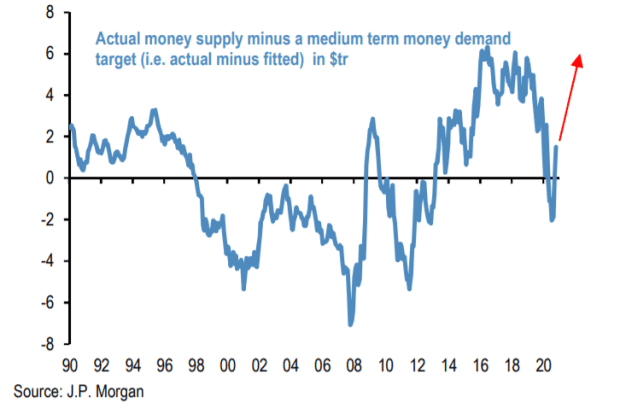This post was originally published on this site

Liquidity is set to be deployed into stocks instead of cash as uncertainty decreases, argue strategists.
Getty Images
One way to think about low interest rates and quantitative easing is that it’s like kindling — while it can be used to set a fire, it still needs something to ignite it.
That’s basically the argument of JPMorgan’s global quantitative team, led by Nikolaos Panigirtzoglou. In a note to clients, he said a gradual decline in uncertainty from the high levels seen before the U.S. election will reduce the need for precautionary savings. Vaccine developments also will help uncertainty to decline.
“This means that a greater portion of the liquidity that has been injected so far as a function of QE [quantitative easing] and credit creation, would be deployed into higher yielding noncash assets such as equities into next year,” he said.

His team constructed a model of money demand — based on nominal gross domestic product, the fact cash is a competing asset class to stocks and bonds, and uncertainty. (There’s an uncertainty index based on newspaper coverage of the economy.) Further normalizations of uncertainty would lead to even higher levels of excess liquidity, Panigirtzoglou said.
While the model leads to a fair value for the S&P 500 SPX, -0.47% of 3,172 at the end of 2020, it vaults to about 4,190 by the end of 2021. “This effectively means that the market has looked through the short-term spike in uncertainty as well as much of the hit to 2020 earnings, but still has another 15% of upside by end-2021,” he wrote.
He also commented about the rotation to value stocks, and pointed out that biotech Moderna’s MRNA, -4.90% vaccine news had less of an impact than drugmaker Pfizer’s PFE, +1.84% did. The bond market reaction also was notable, as yield on the 10-year has gone back down after approaching 1%.
“The failure of core bond yield curves to steepen following this week’s vaccine announcement by Moderna presents in our opinion an additional near-term headwind for the value rotation trade,” he said.
The buzz
For all of the hope around vaccines — Pfizer says its coronavirus vaccine it’s making with BioNTech BNTX, -5.01% is 95% effective, up from its initial estimate of 90% effectiveness — the current COVID-19 situation is still bleak. Hospitalizations in the U.S. reached a record 76,823 on Tuesday, according to the COVID tracking project, while Tokyo saw a record 493 cases.
Target TGT, -0.88% shares rose 3% in premarket trade as the discount retailer reported much stronger third-quarter earnings than forecast.
Home-improvement retailer Lowe’s LOW, -1.26% fell 6% in premarket trade after it met earnings estimates in the third quarter, as comparable sales in the U.S. jumped 30%. Lowe’s also guided for fourth-quarter earnings per share between $1.10 and $1.20, compared with analyst estimates of $1.16.
After the close, graphics microchip maker Nvidia NVDA, -0.68% reports results.
Boeing BA, +3.78% shares rose 5% in premarket trade as the Federal Aviation Administration ended the grounding of the 737 Max.
A day after worse-than-forecast retail sales but better-than-forecast industrial production, the economics calendar includes housing starts for October, and commentary from New York Federal Reserve President John Williams and St. Louis Fed President James Bullard.
The markets
There was a slight upward tilt to U.S stock futures ES00, +0.33% NQ00, +0.17%. The dollar DXY, -0.08% dropped, as did gold GCZ20, -0.83%. Bitcoin BTCUSD, +2.46%, meanwhile, topped the $18,000 level and has jumped 41% in the last month.
Oil futures CL.1, +2.29% rose a day after an informal gathering of the Organization of the Petroleum Exporting Countries and Russia was reported to discuss keeping existing cuts for up to six more months.
The yield on the benchmark 10-year Treasury TMUBMUSD10Y, 0.864% was 0.87%.
Random reads
“To be honest, I don’t really like basketball.” That’s Anthony Edwards, who may become the first overall selection in Wednesday night’s National Basketball Association draft.
Let’s get ready to rumble — fossils show Triceratops and T. rex may have died after a battle.
Need to Know starts early and is updated until the opening bell, but sign up here to get it delivered once to your email box. The emailed version will be sent out at about 7:30 a.m. Eastern.

